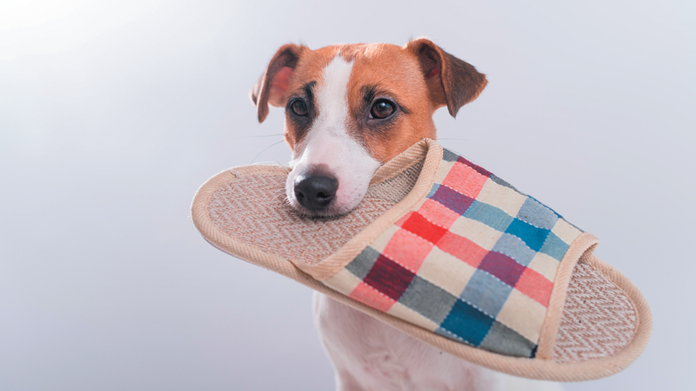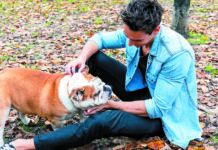How is it that some people are able to train their dogs to perform complicated tricks, like rolling over and playing dead — or fetching someone’s slippers from another room or even another floor of the house?
They do it by using a process that animal behaviorists call shaping, which leads a dog through gradual approximations of a behavior until you get her to engage in the very behavior you have in mind. It takes patience, but the rewards can be great for both you and your dog, who wants to employ her active mind.
Start with something simple
Tricks that take more than one move are called complex behaviors, and the best way to teach your pet is to start with a relatively easy one. It can be as simple as training your dog to put all four paws on a mat and stay there. There are a number of ways to tackle it, but one is to walk across the mat with a bag of treats in your pocket. Your dog will follow you, and as soon as she sets one paw on the mat, give her ample verbal praise and reward her with a treat.
Once she has that part of the trick down, stop rewarding her for putting one foot on the mat and give her praise and a treat only when two paws go there. After a while, cease rewards for two paws and save them only for when all four paws end up on the mat. The final lesson: teaching her to remain on the mat once she’s standing on it with all of her paws.
Once the dog has learned to stay on the mat, you can begin to add a verbal cue: “Go to the mat.” That way, your dog will learn that a reward comes only if you cue her to go to the mat, not simply if she decides to go on her own.
Graduating to more complicated tricks
Let’s say you want to teach your dog to roll over and play dead when she hears the words, “bang bang.” First, you have to teach her to lie down, which many dogs already know from having been taught the “down” cue. Reward her for that behavior, then lure her to roll over on her side by holding a treat on the opposite side of the direction her mouth is facing when she’s down on the floor. When she complies, reward her for that behavior, too.
After a while, you can cue her to lie down and then immediately cue her to roll. From there, reward her only when she completes the entire chain of lying down and then rolling so she stops thinking of it as a two-step process. Then add the words “bang bang” so she learns to do the behavior in response to a verbal cue.
Taking it to the next level
Okay, time to teach your dog to bring you your slippers — from upstairs. (This will be easier for a dog who has some retriever in her, since retrieving is in her blood, literally.)
It’s best not to begin with your actual slippers, which your pet probably won’t find intrinsically exciting. Instead, start with a really good toy.
Reward your dog with praise and a treat simply for picking up the toy with her mouth. Then reward her when she picks it up from the staircase, where you have placed it when she wasn’t looking. Follow that by placing the toy on a higher step and rewarding her only when she picks it up from that higher perch.
Eventually (this could take a few weeks), enthusiastically add a verbal cue: “Go get your toy!” Reward her for complying with that cue, and keep putting more and more distance between her and the toy until she gets to the point that she’s able to follow through on retrieving it even when it’s out of sight in one of the upstairs bedrooms. Because she knows that warm praise and a treat will follow, it should be easy enough to teach her to come back to you with the toy in her mouth.
Now switch to your slippers. Maybe scent them with something your dog finds pleasant.
A flexible approach
For any of the tricks you want to teach your dog, there’s no one correct sequence of events. Sometimes, for instance, you may decide to shape your dog’s behavior when she does something by accident, then work up to rewarding her when she does it in response to your cue. That’s called the “capture method” because you’re capturing your pet in the moment rather than creating the moment.
Let’s say you’d like your dog to go and ring a bell by the door when she wants to go out. At some point she will happen to bump into it. The bell will ring and presto, you immediately give her a treat and open the door, even though she may not have been signaling that she wants to leave the house. After a while, she will get the message that if she rings the bell on purpose, you will open the door for her.
What must remain consistent throughout the training, no matter how it shapes up, is that it stays fun for the dog. You will know she is becoming frustrated if she starts to lick her lips, wander around sniffing, or drink some water even if she has already satisfied her thirst. All of those are signs that she is uncomfortable and losing focus. They can even be signs that she doesn’t want to disappoint you but feels stuck.
If at any point you feel she is becoming frustrated, return to an easier behavior that she has already mastered and proffer the cue (and reward) for it so she will feel successful. It can be something as basic as “sit.” That’s the way to keep your dog well trained and happy.
For especially good results, you can click a clicker at the very moment that your dog does exactly what you want, even when you’re just starting out training her to perform a complex behavior. The sound of the clicker acts as a secondary reinforcer because it can occur even faster than your verbal praise or the offer of a treat. It essentially says to the dog, “You’ve succeeded and a reward will follow.”
It’s akin to getting an e-mail notice that your paycheck has been direct deposited in your bank account. You feel paid even though you don’t yet have the cash in hand, and it’s predictable. Every time you get the notice, real money follows.
Clickers are used not just to train dogs but also to train dolphins to jump through hoops. First a trainer simply puts the hoop on the water. When the dolphin goes near it, she gets a click and a treat. Once she has that down, she only gets a click and a reward upon swimming through the hoop as it’s held at the water’s surface. From there the trainer elevates the hoop in the air little by little over time, always with clicking and rewarding, until the dolphin can literally fly through it to the delight of all — including herself.
Dolphins are awfully smart, but your dog will also appreciate the extra prompt a clicker offers.





